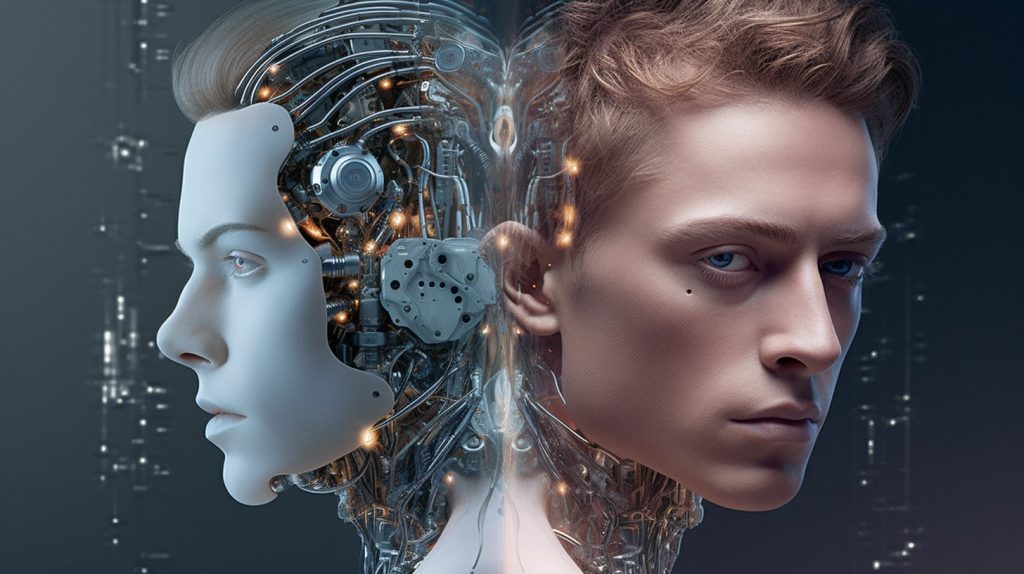Comments
- No comments found

Technological advancements and artificial intelligence are expanding human sensory perception, ushering in a new era of enhanced human experiences.
Neuroprosthetics, like cochlear and retinal implants, are already restoring and augmenting sensory functions. Additionally, new senses are emerging, such as wearable devices that detect environmental factors and the possibility of perceiving electromagnetic fields and WiFi signals. These “techno-senses” create a symbiotic relationship between humans and AI, revolutionizing healthcare, communication, and scientific research. The convergence of multiple senses enriches our understanding of the world, and as technology continues to evolve, there are exciting possibilities for further enhancing and expanding our multisensory experiences. We are entering a transformative phase where AI’s techno-senses and our enhanced sensory capabilities converge, giving rise to an enriched reality.
In our current epoch—the cognitive age, we stand at the threshold of a radical shift in our fundamental understanding of sensory perception. Traditionally, our interaction with the world has been defined by the five primary human senses — sight, sound, smell, taste, and touch. However, as the technological landscape continues to evolve, we are witnessing a potential transition from this five-dimensional sensory framework to an ‘n-dimensional’ one.
This transformation does not imply physiological evolution, but rather, an augmentation of our existing sensory modalities through technological advancements and artificial intelligence. The advent of augmented reality, virtual reality, neuroprosthetics and bio-electronics interfaces is already hinting at this expansion of sensory experience.
In the arena of sensory augmentation, neuroprosthetics hold considerable promise. Cochlear implants are already enabling the profoundly deaf to hear, while retinal implants could one day restore sight to the blind. The potential to extend these technologies to enhance ‘normal’ sensory function, such as extending human hearing into the ultrasonic range or visual perception into infrared or ultraviolet spectrums, may on the horizon.
The possibilities for entirely new senses are also unfolding. Imagine wearable devices that sense environmental factors like radiation levels or air quality, or the possibility of sensory substitution, allowing us to perceive key aspects of electromagnetic fields or WiFi signals.
As we navigate this sensory renaissance, it becomes crucial to ensure that these advancements enrich our lived experience and understanding of the world around us. Concurrently, the technological advancements in AI are ushering in an era of ‘techno-senses’ that could redefine the interaction between humans and machines and foster an entirely perceptual reality that lives beyond the walls of our traditional 5 senses.
The advent of these techno-senses offers the potential for human and AI symbiosis. They allow us to perceive and interpret reality in ways that were previously inaccessible, expanding our own sensory experiences.
AI systems equipped with data sonification could revolutionize healthcare, enabling doctors to ‘listen’ to patient health data. Electromagnetic sensing AI could transform communication, potentially predicting interruptions or vulnerabilities in networks. And quantum sensing AI could lead to breakthroughs in various scientific fields, pushing the boundaries of human knowledge.
The blending of multiple sensory perceptions creates a rich tapestry of experiences that form the bedrock of our interaction with the world. Sight, sound, smell, taste, and touch do not operate in isolation; instead, they converge and interplay in a symphony of sensory input, giving depth and nuance to our experiences. For instance, the taste of food is enhanced by its aroma, visual appeal, and even the crunching sound it makes when we bite into it. Similarly, a piece of music can stir more profound emotions when paired with a powerful visual performance.
This unique amalgamation of sensory inputs is what allows us to have vivid, multidimensional experiences, enriching our understanding and appreciation of our surroundings. As technology and AI continue to evolve, they open exciting possibilities for augmenting and expanding this multisensory panorama, offering us new ways to perceive and interact with the world.
We stand at the threshold of a new age, where AI’s ‘techno-senses’ and humanity’s enhanced sensory capabilities converge to create an enriched sensory reality. It is an era that beckons us to explore new horizons of understanding, to conceive of new ways of experiencing the world, and to embrace the extraordinary possibilities offered by this sensory renaissance.
John is the #1 global influencer in digital health and generally regarded as one of the top global strategic and creative thinkers in this important and expanding area. He is also one the most popular speakers around the globe presenting his vibrant and insightful perspective on the future of health innovation. His focus is on guiding companies, NGOs, and governments through the dynamics of exponential change in the health / tech marketplaces. He is also a member of the Google Health Advisory Board, pens HEALTH CRITICAL for Forbes--a top global blog on health & technology and THE DIGITAL SELF for Psychology Today—a leading blog focused on the digital transformation of humanity. He is also on the faculty of Exponential Medicine. John has an established reputation as a vocal advocate for strategic thinking and creativity. He has built his career on the “science of advertising,” a process where strategy and creativity work together for superior marketing. He has also been recognized for his ability to translate difficult medical and scientific concepts into material that can be more easily communicated to consumers, clinicians and scientists. Additionally, John has distinguished himself as a scientific thinker. Earlier in his career, John was a research associate at Harvard Medical School and has co-authored several papers with global thought-leaders in the field of cardiovascular physiology with a focus on acute myocardial infarction, ventricular arrhythmias and sudden cardiac death.
Leave your comments
Post comment as a guest